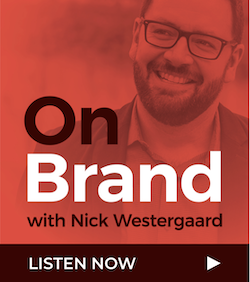Believe it or not, one of the questions I hear most often is – what is a brand? It’s no secret that I am a brand-driven guy. As exciting as new technology is, I’ve always viewed social and digital media innovations as incredible tools for building better brands. That alone should be evident in both the name of this blog and the renamed division of our business, Brand Driven Digital.
However, in whipping up all of this excitement around the concept of building brands, it made me start thinking about that very basic question I am so often asked …
So, What Is a Brand?
Any good semantic exploration should start in the dictionary with our basic understanding of the word. Surprisingly, our business-focused definition has overtaken the word’s earliest meaning. That is to say that the first definition is no longer a mark made by burning or otherwise, to indicate kind, grade, make, ownership. Rather, the first definition is simply kind, grade, or make as indicated by stamp, trademark or the like. Gee thanks, Webster’s. At least we aren’t burning things anymore!
Instead of relying on the dictionary, I’ve created the following definition.
A brand can be any noun (person, place, or thing) that needs someone else to take action (purchase, promote, advocate, and so on). A brand does this by creating a series of ideas and touch points that build a larger message which draws the desired party close, engages them emotionally, and inspires them to take action.
In digging a little deeper I think it’s important to consider what a brand is and what it is not.
A brand can be a …
- Business — Nike, Apple, Starbucks
- Product — Air Max, iPod, Verisimo
- Organization — Humane Society, Planned Parenthood, United Methodist Church
- Person – Professional, politician, and celebrities such as Tony Robbins, Barack Obama, and Taylor Swift
- Places — Communities, cities, countries such as The Research Triangle, Chicago, the United States
- Things that fall in the spaces between but still need others to rally around them like our landmarks and special causes.
In reading this you could start to think that anything could be brand. As such let’s take a look at some of the limiting constructs people often apply in defining what a brand is.
A brand is not just …
- Your logo
- Your slogan, mission, positioning statement, or credo
- What your website copy says
- What’s on the back of your business card
- How your employees engage customers and prospects online and off
- What others say about you
- What you do on social media sites like Facebook, Twitter, Pinterest, Instagram, Google+, YouTube, etc.
Notice how I said it’s not just the items listed above. However, it is all of these items working together in concert. These are the aforementioned touch points that work together to define who your brand is and what it’s all about.
In looking at what our brand is and what it’s not, we need to at the same time expand and contract our thinking around these concepts. With this insight as a launchpad, we can set many of the above items into motion to create that bigger picture. The whole that comes from the sum of the parts. Brands are gestalt psychology in action.
The first step in doing any of this is understanding what your brand is at it’s most pure essence. What kind of noun are you and what action do you need from that critical constituency you serve.
Why Is It Important to Define What a Brand Is?
It’s important to understand that brands are the constant. One of the earliest forms of marketing was the local marketplace, where proprietors called out like carnival barkers in an effort to promote their wares — at times even using a megaphone to stand out among the noisy crowd.
When we look at our current fragmented media landscape — which is evolving at a more rapid pace than we’ve ever seen thanks to the internet — it’s obvious that this marketing megaphone is changing rapidly. Our gut reaction is to intensify our own focus on how tools like social media are changing this megaphone instead of taking a good, hard look at the brand standing behind that megaphone.
Is your brand fleshed out fully? Does it stand for something that can make it through this new megaphone and across all of the new tools the web has to offer? Or is your new logo and branding PowerPoint from your agency what your brand stands for? Many opt for the latter because it’s an easy way to check that “branding thing” off the list. However, great brands of all shapes and sizes aren’t afraid to take a step back and examine what’s behind their marketing megaphone.
Which one are you? Or, better still, which one do you aspire to be?
Editor’s note: This is the first in a series of posts on how to build a better brand in the digital space. Subsequent posts will focus on defining what your brand stands for, who you serve, the digital touch points you can use to bring your brand to life, and the brand advocates you want to rally around you.









